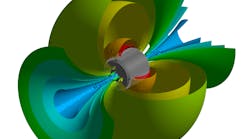Ansys updated its core software to faithfully simulate how wireless signals react to colliding with trees and buildings as well as hitting patches of electromagnetic interference and rainfall.
The tweaks to the company's software come as engineers face challenges to understanding the nature of millimeter waves. These high frequency bands are incapable of passing through walls and grapple with other shortcomings. But they are considered vital for 5G communications. Automotive radar systems also harness them to sweep roads for potential dangers.
The updates, announced on Tuesday, are not limited to Ansys' electromagnetic software. Mark Hindsbo, vice president of the firm's design and platform business, said in a statement that the software announced Tuesday provides “enhanced speed and accuracy – enabling more users, no matter their level of experience, to reduce development time and increase product quality.”
Ansys added shooting-and-bouncing-ray algorithms to its electromagnetic tool HFSS, which uses sophisticated solvers to flag emissions and coupling issues. The latest solver visualizes the performance of antennas mounted onto airplanes and cars, which are difficult to simulate without lots of processing power.
Ansys also now includes better visualization and modeling of antennas, which helps engineers find the ideal location for them inside gadgets or large structures like ships. The firm also rolled out an RF link analysis tool that shows how interference hampers radio waves. It can assess the effects of rain, buildings, atmospheric absorption, and statistical signal fading.
The software is another tool with which engineers can chart the behavior of millimeter waves, which are particularly susceptible to signal fading over long distances. Ansys is not alone in trying to make that evaluation process easier: In June, Remcom added diffuse scattering prediction to its radio propagation software.
Other changes also shave down the complexity of meshing, which entails laying triangular cells on models to prep them for simulation. Ansys added what it calls broadband adaptive meshing, which automates the ability of HFSS to refine and optimize the mesh using information taken from a device’s frequency spectrum.
Also new are enhanced circuit simulation capabilities. Ansys allows engineers to assemble an electronic system with packaging, sockets, printed circuit boards, and connectors in three dimensions. Then, the entire system can be subjected automatically to electromagnetic and transient circuit analysis.
